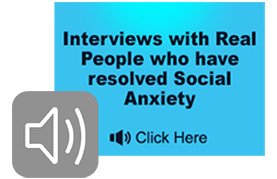Ask Jonathan
Dissociating vs “obsessing” in Selective Mutism
Asked By: Anonymous Views: 963 times
This is the first time I’ve heard SM being a variation of OCD where the ‘obsessive’ part refers to the worrying. And ‘compulsive’ refers to the verbal shutdown. It makes a lot of sense. In one of the interviews I listened to on the website (can’t remember which), I heard that people with SM become very good at detaching themselves from the source of whatever is causing their anxiety. Not only a verbal shutdown, but also a mental removal from the situation. And to my understanding this disassociation is what manifests into chronic avoidant behavior. The worrying and disassociation seem to be two separate and opposing states of mind. The worrying entails the anxiety and adrenaline rush, whereas the disassociation is just shutting down completely and avoiding it all together. That way the adrenaline can be “controlled,” so to speak. I have a few questions. Two of them are: at what point does the worrying turn into disassociation or are they the same thing? And how can you tell them apart from an outside point of view? It seems like a child with SM is less likely to have learned to cope by dissociating, and the adult with SM would be the opposite – dissociating more in order to feel less anxiety. And is this where the difficulty with taking initiative stems from?

Detachment is the defense mechanism by which the selectively mute child, or any individual experiencing social anxiety, learns to disconnect from discomfort. Detachment is the doorway to avoidance. Avoidance can evolve into an addiction. With selective mutism detachment starts early on, and is perpetuated by enabling as the children learn via the enabling process, they do not have to connect to anxiety and worry. The longer the SM exists the more ingrained detachment becomes. In my opinion worrying evolves into detachment –disassociation quickly as the sufferer is desperate to escape the distress of anxiety. In the DVD training program “Social Anxiety: The Untold Story”, “Paul”, a gifted salesman explains his detachment saying “No matter what happens tomorrow it’s not as important as today”. He means that whatever the repercussion of avoidance, the hierarchy of needs is to detach from the anxiety and discomfort in real time. While I’ve heard just about everything in my 35 year plus clinical career with thousands of patients of all ages, I’m still amazed at the proficiency of detachment skills that I encounter. In the typical SM children’s profile the child is substantially disconnected from worry. This worry accrues and becomes more ingrained with time the more that enabling is present. In addition, the more that detachment and avoidance accrues, the more the child is at risk for the possible delusion that the world will adapt to him or her. The worry (obsessiveness) exists in different levels of consciousness. This energy recycles and drives the compulsive verbal shutdown. An integral component of the Berent Treatment Model is the belief that “you have to feel that which you want to control”. Therefore; nurturing the SM child, with support and insight, into identifying age appropriate cognition and emotionality has had profoundly productive clinical results. In addition, this process builds emotional intelligence! A crucial component of treatment for social and performance anxiety is learning to put a positive “spin”, or nurturing interpretation, on the adrenaline-driven visceral discomfort. What sucks the life out of “initiative” is the drive and compulsion to avoid the pain of anxiety. The silver lining with selective mutism is that with productive early intervention, there Is substantial potential to prevent the anxiety from evolving into avoidant and dependent personality disorder and lifestyle.
The following is part of a collection of questions and sharing by our readership community about a wide variety of aspects of social anxiety. Dive in and receive practical insights and advice. If you have a question that is not included you can contact Jonathan at jberent@socialanxiety.com.



